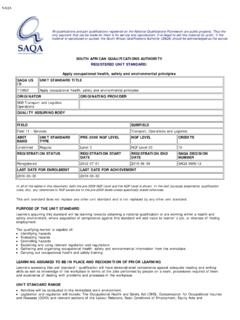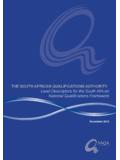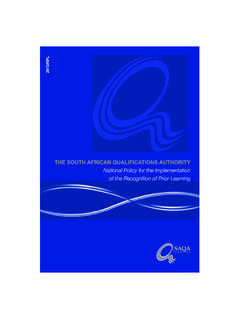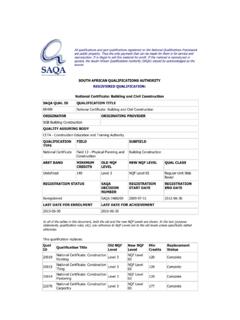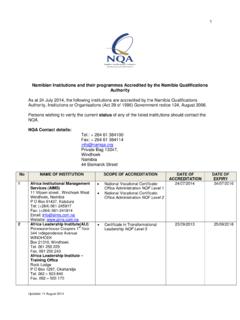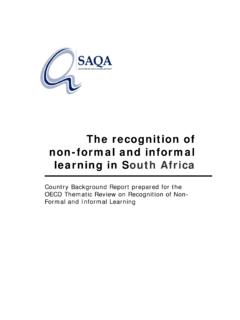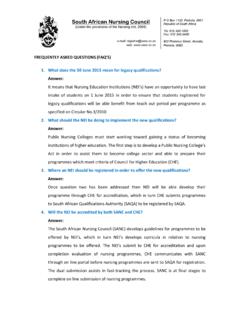Transcription of SAQA SOUTH AFRICAN QUALIFICATIONS …
1 [11/8/2012 11:53:38 AM]All QUALIFICATIONS and part QUALIFICATIONS registered on the National QUALIFICATIONS Framework are public property. Thus theonly payment that can be made for them is for service and reproduction. It is illegal to sell this material for profit. If thematerial is reproduced or quoted, the SOUTH AFRICAN QUALIFICATIONS Authority (SAQA) should be acknowledged as the AFRICAN QUALIFICATIONS AUTHORITY REGISTERED UNIT STANDARD: Use mathematics to investigate and monitor the financial aspects of personal, business and national issues SAQA US ID UNIT STANDARD TITLE7456 Use mathematics to investigate and monitor the financial aspects of personal, business and national issues ORIGINATORORIGINATING PROVIDERSGB Math Literacy, Math, Math Sciences L2 -4 QUALITY ASSURING BODY- FIELDSUBFIELDF ield 10 - Physical, Mathematical.
2 Computer and Life SciencesMathematical Sciences ABET BAND UNIT STANDARD TYPE PRE-2009 NQF LEVEL NQF LEVELCREDITSU ndefined Regular-Fundamental Level 3 NQF Level 03 5 REGISTRATION STATUSREGISTRATION STARTDATEREGISTRATION ENDDATESAQA DECISIONNUMBERR eregistered 2012-07-01 2015-06-30 SAQA 0695/12 LAST DATE FOR ENROLMENTLAST DATE FOR ACHIEVEMENT2016-06-30 2019-06-30 In all of the tables in this document, both the pre-2009 NQF Level and the NQF Level is shown. In the text (purpose statements, qualificationrules, etc), any references to NQF Levels are to the pre-2009 levels unless specifically stated otherwise.
3 This unit standard does not replace any other unit standard and is not replaced by any other unit standard. PURPOSE OF THE UNIT STANDARD This unit standard will be useful to people who aim to achieve recognition at some level in Further Education and Training or to meet the Fundamental requirement of a wide range of QUALIFICATIONS registered on the National QUALIFICATIONS Framework. People credited with this unit standard are able to: Use mathematics to plan and control personal and/or household budgets and income and expenditure. Use simple and compound interest to make sense of and define a variety of situations including investments, stokvels, inflation,appreciation and depreciation.
4 Investigate various aspects of financial transactions including costs, prices, revenue, cost price, selling price, loss and profit. LEARNING ASSUMED TO BE IN PLACE AND RECOGNITION OF PRIOR LEARNING The credit value is based on the assumption that people starting to learn towards this unit standard are competent inMathematics and Communications at NQF level 2. UNIT STANDARD OUTCOME HEADER Use mathematics to plan and control personal, regi Specific Outcomes and Assessment Criteria: SAQASPECIFIC OUTCOME 1 Use mathematics to plan and control personal, regional and/or national budgets and income and expend OUTCOME NOTES Plans describe projected income and expenditure realistically.
5 Calculations are carried out using computational tools efficiently and correctly and solutions obtained are verified in terms ofthe context. Budgets are presented in a manner that makes for easy monitoring and control. Actual income and expenditure is recorded accurately and in relation to planned income and expenditure. Variances areidentified and explained and methods are provided for control. OUTCOME RANGE Bank accounts, provincial and key elements of national budgets and tax. ASSESSMENT CRITERIA ASSESSMENT CRITERION 1 Use mathematics to plan and control personal, regional and/or national budgets and income and expenditure.
6 ASSESSMENT CRITERION NOTES Plans describe projected income and expenditure realistically. Calculations are carried out using computational tools efficiently and correctly and solutions obtained are verified in terms ofthe context. Budgets are presented in a manner that makes for easy monitoring and control. Actual income and expenditure is recorded accurately and in relation to planned income and expenditure. Variances areidentified and explained and methods are provided for control. ASSESSMENT CRITERION RANGE Bank accounts, provincial and key elements of national budgets and tax. SPECIFIC OUTCOME 2 Use simple and compound interest to make sense of and define a variety of situations.
7 OUTCOME NOTES The differences between simple and compound interest are described in terms of their common applications and effects. Methods of calculation are appropriate to the problem types. Computational tools are used efficiently and correctly and solutions obtained are verified in terms of the context or problem. Solutions to calculations are used effectively to define the changes over a period of time. OUTCOME RANGE Effective and nominal rates, commission, appreciation and depreciation. ASSESSMENT CRITERIA ASSESSMENT CRITERION 1 Use simple and compound interest to make sense of and define a variety of situations.
8 ASSESSMENT CRITERION NOTES The differences between simple and compound interest are described in terms of their common applications and effects. Methods of calculation are appropriate to the problem types. Computational tools are used efficiently and correctly and solutions obtained are verified in terms of the context or problem. Solutions to calculations are used effectively to define the changes over a period of time. ASSESSMENT CRITERION RANGE Situations include: Effective and nominal rates, commission, appreciation and SPECIFIC OUTCOME 3 Use mathematics to debate aspects of the national economy.
9 OUTCOME NOTES Values are calculated correctly. Mathematical tools and systems are used effectively to determine, compare and describe aspects of the national economy. Debating points are based on well-reasoned arguments and are supported by mathematical information. OUTCOME RANGE Tax, productivity and the equitable distribution of resources. ASSESSMENT CRITERIA ASSESSMENT CRITERION 1 Use mathematics to debate aspects of the national economy. ASSESSMENT CRITERION NOTES Values are calculated correctly. Mathematical tools and systems are used effectively to determine, compare and describe aspects of the national economy.
10 Debating points are based on well-reasoned arguments and are supported by mathematical information. ASSESSMENT CRITERION RANGE Tax, productivity and the equitable distribution of resources. UNIT STANDARD ESSENTIAL EMBEDDED KNOWLEDGE The following essential embedded knowledge will be assessed by means of the specific outcomes in terms of the stipulatedassessment criteria. Candidates are unlikely to achieve all the specific outcomes, to the standards described in the assessmentcriteria, without knowledge of the listed embedded knowledge. This means that the possession or lack of the knowledge can beinferred directly from the quality of the candidate`s performance against the standards.
